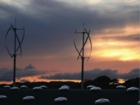Sainsbury’s tries something new in lighting

The new flagship green store of Sainsbury’s in Dartmouth has been designed to halve the energy it takes from the National Grid and to reduce carbon emissions by 40%. Lighting is a major user of energy in such a store, so the use of daylight has been maximised by the installation of 85 Monodraught SunPipes to minimise the use of artificial lighting.
There are 64 SunPipes 750 mm in diameter on the shop floor, giving about 1000 lx at floor level. A further 16 units are fitted in the offices, also 750 mm in diameter, with five more 300 mm-diameter units in other areas.
In staff areas and toilets, motion sensors and daylight dimming ensure that lights cannot be switched on while the SunPipes are providing natural light.
Neil Sachdev, commercial director with Sainsbury’s, comments, ‘Our Dartmouth store is a leader in sustainable construction, being sensitive to its local environment and extremely low in energy usage. We have adopted a number of energy-saving measures — from the Monodraught SunPipes, which provide amazing natural light, to using a timber frame rather than steel, which consumes less energy in its production.
The low-carbon policy extends to daily food deliveries to the store being made by a lorry powered by bio-methane produced from rotting rubbish.







